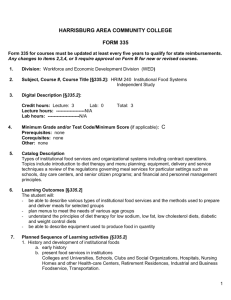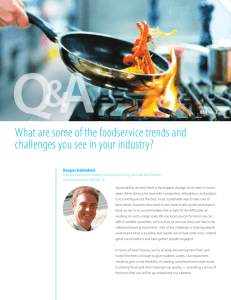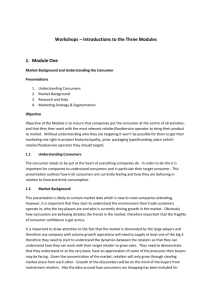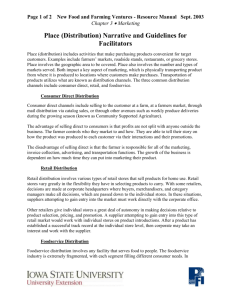single-use foodservice packaging - Foodservice Packaging Institute
advertisement
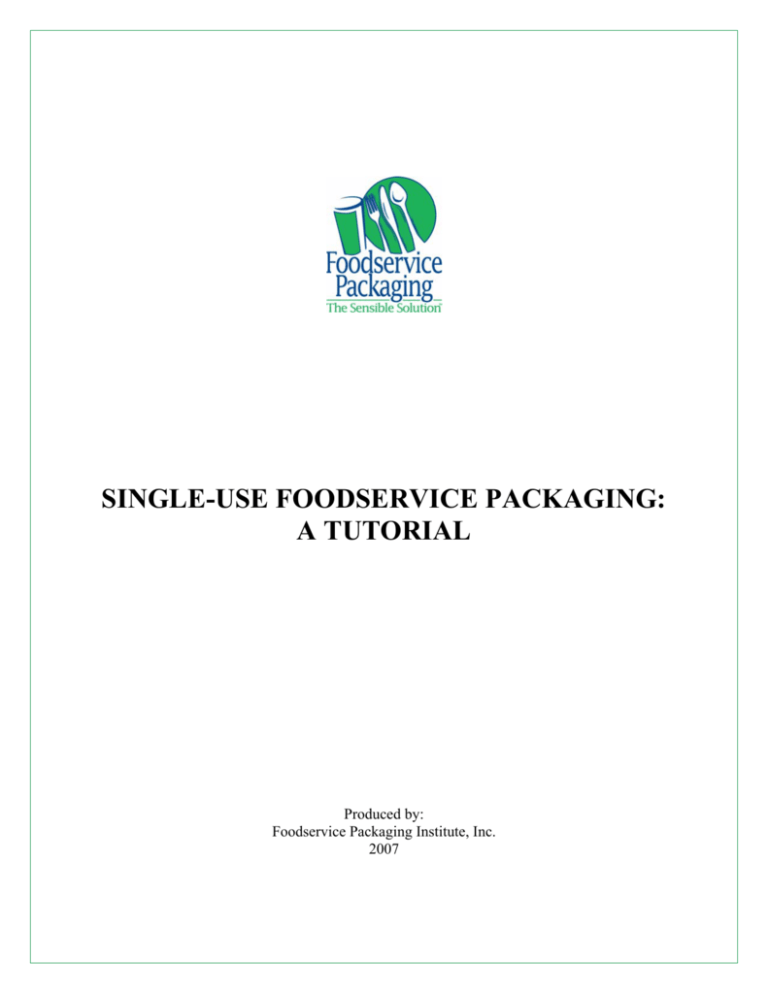
SINGLE-USE FOODSERVICE PACKAGING: A TUTORIAL Produced by: Foodservice Packaging Institute, Inc. 2007 HISTORY OF FOODSERVICE PACKAGING Most people don’t realize that single-use foodservice products (also known as foodservice disposables) have been around since 1904. The first single-use foodservice product invented was a paper plate used to support cakes in bakeries. But it was the cone-shaped paper drinking cup that caught the public’s attention. It replaced the common metal drinking cup that a Kansas doctor discovered was spreading serious contagious diseases. Over the years, other kinds of single-use foodservice products became available when the need arose for sanitary, inexpensive, lightweight items to serve food and drinks to factory workers, military troops, school children and hospital patients. Since the 1960s, single-use foodservice products have become a familiar part of every day life in America. Those paper, plastic, foam, aluminum and new alternative material products are well known to anyone who wants to grab a quick meal, snack or drink to take to home, school, work, the game, the movies… or any place where prepared meals and drinks are served to consume immediately or to carry out. They’re also used in hospitals, nursing homes, grocery delis, cafeterias, or institutional eating facilities. And, single-use foodservice products are used to serve nourishing, comforting meals to the victims of natural disasters – tornadoes, floods, hurricanes, and earthquakes. Single-use foodservice products are well known in America because they’re so widely used, and this will continue. With the increasing number of single-person households, dual-income and single-parent families, consumers are looking for convenient meal solutions, and foodservice operators are looking to meet these needs. And single-use foodservice packaging makes it possible. © Foodservice Packaging Institute, Inc. 2007 1 SANITARY BENEFITS OF FOODSERVICE PACKAGING Single-use foodservice products have been known as the “sanitary alternative” to china and glassware for serving meals. That’s because these products are manufactured clean, and if handled properly, they’ll stay clean until they’re used. Once used, they can be discarded, so germs don’t have a chance to grow and spread. Single-use foodservice products can actually help stop the spread of germs that cause illness and disease. Food borne illness in the United States is a major cause of personal distress, preventable death, and avoidable economic burden. It has been estimated that food borne diseases from bacteria and viruses cause approximately 76 million illnesses, 325,000 hospitalizations, and 5,000 deaths in the United States each year. And, Health Canada estimates that the annual costs related to food borne illnesses and deaths exceed $1 billion. And keep in mind… just because something gets washed doesn’t mean it gets clean. To kill germs, water has to be very hot and detergents need to be strong, anti-bacterial agents. A 2002 study involving coffee bars, restaurants, delis and day care centers in Clark County, Nevada, found that 18 percent of reusable foodservice items tested (cups, plates, bowls and utensils) weren’t clean; they had more than the generally accepted standard of 100 colonies of bacteria per item. Only eight percent of the single-use items tested also exceeded that standard. But it’s not just the packaging you have to be concerned about. The use of paper placemats or tray covers provides a more sanitary eating surface than uncovered tabletops or trays. According to a study conducted in 2006 by the University of Wisconsin, Oshkosh, placemats were shown, on average, to have just 14 percent of the bacteria found on uncovered tables in restaurants. Similarly, tray covers were shown, on average, to have as little as five percent of the bacteria found on uncovered trays in hospitals, lodging and long-term care facilities. Public health officials also say the food safety and sanitation benefits of single-use foodservice products far outweigh any perceived impact on the environment. For this reason, the Food and Drug Administration’s Food Code requires that “A food establishment without facilities... for cleaning and sanitizing kitchenware and tableware shall provide only single-use kitchenware, single-service articles, and single-use articles for use by food employees and single-service articles for use by consumers.” © Foodservice Packaging Institute, Inc. 2007 2 FOODSERVICE PACKAGING MATERIALS Single-use foodservice products are typically made from paper, plastic or aluminum. In recent years, the industry has also started making these products from various “alternative materials.” All these materials are lightweight, relatively inexpensive, and are easily formed into the various shapes of single-use foodservice products. Regardless of what material these products are made with, manufacturers of single-use foodservice products are subject to federal government regulations that ensure the products’ safety to the environment and to the people who use them. Paper Foodservice products made from paper include cups, plates, bowls, napkins, carryout bags, trays, egg cartons, doilies, tray liners, and more. Paper products are manufactured from pulp and paperboard, which come from trees, a renewable resource. The paper industry grows trees for its products, and when the trees reach a certain height or maturity, they’re harvested. And, for all the trees that it harvests each year, the forest industry replants new seedlings. After the trees are harvested, they are processed for papermaking. The branches are cut off, the bark is stripped, and then the wood is broken down into pulp, a mushy substance made up of tree fibers and water. The wastes from those processes are not discarded, but rather used in the papermaking operation. Modern papermaking machines move the material at great speeds over a series of rollers that continuously flatten, wring out the water, and dry the paper into the finished product. Other machines convert the paper into foodservice packaging products. In addition to paper and paperboard products, molded fiber products are made from recycled paper and are formed under heat and pressure into plates, bowls, trays and cup carriers Foodservice paper products use only a very small portion of wood pulp resources. Plastic Many single-use foodservice products are made of plastic: cups, plates, bowls, trays, food containers and cutlery, for example. Plastics are used because the material is lightweight and holds the temperature of hot/cold food and beverages. Polystyrene (PS) is in one of the most common types of plastics used for foodservice packaging. In its foamed form, polystyrene is often incorrectly referred to as “Styrofoam.” Styrofoam™ is actually the brand name for building materials, pipe insulation and floral and craft products made by The Dow Chemical Company. There isn’t a coffee cup, cooler or packaging material in the world made from Styrofoam™. © Foodservice Packaging Institute, Inc. 2007 3 In recent years, foodservice packaging manufacturers have also started to make their products from other polymers, including polypropylene (PP) and polyethylene terephthalate (PET or PETE). Plastic single-use foodservice products are resource-efficient, that is, a lot of products are made with a very small amount of raw material and they can give off a lot of energy when they’re burned as waste material. Petroleum and natural gas are the sources for most plastic products, but these products use only four percent of total petroleum resources. And, single-use foodservice packaging accounts for a very small portion of plastic products. Aluminum Although most people think of food wrap when aluminum products come to mind, aluminum is also used to manufacture bags, containers and trays. Aluminum is made from bauxite ore. Bauxite is refined and treated to produce alumina, a white powdery oxide. The aluminum is extracted from the alumina and then melted and cast into ingots for use in manufacturing products. Because the cost of making aluminum products from the raw, extracted material is so high, most aluminum used in single-use foodservice products comes from recycling processes. Aluminum recycling is also a big energy saver. The production of aluminum from recycled products saves 95 percent of the energy required to make aluminum from bauxite ore. Alternative Materials A number of manufacturers are now making single-use foodservice products from a combination of natural starches, recycled fibers, water, air, and natural minerals. These composite products include cups, plates, bowls, cutlery, sandwich wraps, food containers and trays. The agricultural commodities used to make these single-use foodservice products include corn, potatoes, rice, grasses, bamboo and other plants that are grown for their starch or for their fibrous pulp. Some products are made from a mixture of pulp fibers that are molded into single-use foodservice items with heat and pressure. Others are made from a composite or mixture of starch and other materials, such as limestone and recycled fibers, which give them additional strength. © Foodservice Packaging Institute, Inc. 2007 4 FOODSERVICE PACKAGING FEATURES AND FUNCTIONS Today’s foodservice packaging offers more options to ensure that the packaging meets the needs of operators and their customers. Here are a few things to consider before purchasing foodservice packaging products. What’s going in or on the packaging? The item(s) require(s) that the packaging… • keeps hot items hot • keeps cold items cold • keeps frozen items frozen • needs to be heated, re-heated or cooked in a microwave or oven • doesn’t absorb grease/juice • is leak resistant • has a light or heavy weight/strength What should the packaging look like? It… • is a certain color • is a certain shape • is a certain size, i.e. single portion versus multi-serving • has different compartments • has a base and lid hinged together • has a base and lid in two pieces • has different dome or lid options for the same base • needs to part of a family of packaging options • is film-sealable or tamper-resistant • has graphics or printing on it, such as a logo or special design • has an area for labels, such as nutritional information or heating instructions What will you do with the packaged item? • store it in a hot display case • store it in a cold display case • store it in a freezer case • place it under a heat lamp or in a microwave or oven to warm or cook it • lid it • stack it • use with automated equipment What will your customer do with the packaged item? • heat or re-heat it in the microwave or oven • freeze it • open or close it several times • cut and/or eat the items out of the packaging • travel some distance before consuming the food/beverage • use it to present foods, i.e. at catered functions © Foodservice Packaging Institute, Inc. 2007 5 DOS AND DON’TS WHEN CHOOSING FOODSERVICE PACKAGING When choosing foodservice packaging, keep these “dos” and “don’ts” in mind: ♦ DO consider packaging decisions early on during your menu/program development (correct size, cost, food or beverage/temperature compatibility, image, functions, etc.). ♦ DO communicate all the features and functions the packaging should have to your supplier. ♦ DO test samples in actual use, not just dry or empty. For instance: o Do foods and beverages stay hot or cold enough? o Do foods and beverages melt the packaging, or make it soggy, etc.? o Do foods stay separated (if using compartments)? o Do multiple packages stack well for display and transport? o Is it leak resistant? o Is it convenient to eat out of and/or store leftovers? ♦ DO choose packaging that can be used for multiple applications. ♦ DO consider using your foodservice packaging as potential advertising for your operation – distinctive packaging with your name or logo will set your product apart from the others. ♦ DON’T just use the low cost option to save money – it can be a liability and/or doom your program to failure. At the same time, don’t overpay for packaging features you don’t need. ♦ DON’T assume that all foods and beverages can go in the same packaging. ♦ DON’T assume that custom packaging is the best option. It can be expensive and timeconsuming. ♦ DON’T forget to periodically update your packaging, to account for new technology. © Foodservice Packaging Institute, Inc. 2007 6 FOODSERVICE PACKAGING DISPOSAL OPTIONS When disposing of foodservice packaging products, there are several options for you to consider. Discarding in a Landfill The majority of foodservice packaging ends up in a landfill. However, people tend to believe that single-use products are a big part of the country’s solid waste. This simply isn’t true. According to the U.S. Environmental Protection Agency, Americans generated 4.6 pounds of trash every day in 2006, and yet only 1.2 percent was paper and plastic single-use foodservice products. Additionally, most people believe that material biodegrades or composts in a landfill. In fact, this is an undesirable action in a landfill. Unlike composting (see below), the idea of landfills isn’t to help the trash decompose, but simply to cover it, isolate it and keep it from contaminating the air and groundwater. Any decomposition must (by federal law) be carefully monitored and controlled. Recycling Single-use foodservice products can – and are being – recycled. However, just because something can be recycled doesn’t mean it’s always practical to do so. Recycling is a business and for it to work well, certain issues have to be addressed. First, recycling processes use energy and produce waste by-products that have to be managed, and those are costs. There has to be a market for the recycled material that will pay the recycler enough to cover the costs of processing the recovered material. And, recyclers have to consider that if it costs more (and takes more resources) to make a product from recycled materials than from raw materials, then it’s not logical to choose recycled materials. Single-use foodservice products present other challenges to recycling. These products often contain food wastes and become contaminated by human contact. Recycling operations don’t always have the machinery to completely remove those contaminants. Single-use foodservice products can also be very costly to ship because they are light in weight and low in density. Nevertheless, single-use foodservice products are being recycled successfully. Some paper products are recycled into home insulation, parts of corrugated boxes and packing material. Aluminum containers are recycled into beverage cans and other aluminum products. Plastic/foam products are recycled into insulation, building and packing materials, toys and other items. Composting Composting is a natural way of recycling items. Items such as food waste, yard waste, and certain types of foodservice packaging mix with microscopic bacteria, fungi, air and moisture to help break down or decompose these items into compost. Food contamination, which creates a challenge when recycling single-use items, aids in the decomposition of the paper items for a high-quality compost. © Foodservice Packaging Institute, Inc. 2007 7 New foodservice packaging products made from alternative materials – often described as “compostable” or “biodegradable” – should be placed into municipal composting facilities. If not, they lose one of their most valuable (and marketable) attributes. Waste-To-Energy Many materials and products, including single-use foodservice products, can be, and are being, safely converted to produce energy. Waste-to-energy programs burn solid waste at high temperatures creating steam or electricity. This electricity is sold to electricity-generating utilities that distribute it to local homes, businesses and schools. Waste-to-energy, or incineration, is a particularly good option for plastic single-use products. Controlled incineration of polystyrene, for example, generates 17,800 BTUs of energy per pound of polystyrene (double the inherent energy value of coal), creates no harmful emissions, and leaves only trace amounts of harmless ash. © Foodservice Packaging Institute, Inc. 2007 8 SUGGESTED DISCUSSION QUESTIONS 1. Why were single-use foodservice packaging products invented? ANSWER: To stop the spread of contagious diseases. (see page 1) 2. Name one way to fight food borne illness. ANSWER: Use single-use foodservice packaging items to protect foods, beverages and tabletops. (see page 2) 3. What are the materials used to manufacture foodservice packaging. ANSWER: Paper, plastic, aluminum and alternative materials. (see pages 3-4) 4. What foodservice packaging products are made from Styrofoam? ANSWER: Ah ha! A trick question – no foodservice packaging products are made from Styrofoam. (see page 3) 5. What are some of the considerations when choosing foodservice packaging? ANSWER: What’s going in or on the packaging; what should the packaging look like; what will you do with the packaging; and what will your customers do with the packaging. (see page 5) 6. When is the appropriate time to consider packaging decisions? ANSWER: Early on in menu/program development, and periodically after that to account for new technology. (see page 6) 7. How should you test new foodservice packaging products? ANSWER: In actual use. (see page 6) 8. What are the options for discarding single-use foodservice packaging? ANSWER: In a landfill, recycling, composting and waste-to-energy. (see pages 7-8) 9. What is the appropriate option for discarding biodegradable foodservice packaging? ANSWER: Send to a municipal composting facility. (see page 8) 10. Where can you turn to answer your questions concerning single-use foodservice packaging? ANSWER: The Foodservice Packaging Institute (FPI) is the leading authority on singleuse foodservice packaging products in North America. Answers to many questions may be found on their Web site at www.fpi.org. (see page 10) © Foodservice Packaging Institute, Inc. 2007 9 QUESTIONS If you have any questions regarding single-use foodservice packaging, please contact: Foodservice Packaging Institute, Inc. 150 South Washington Street Suite 204 Falls Church, VA 22046 Phone: (703) 538-2800 ♦ Fax: (703) 538-2187 E-mail: fpi@fpi.org ♦ Internet: www.fpi.org © Foodservice Packaging Institute, Inc. 2007 10
